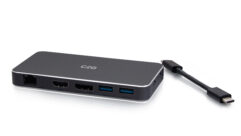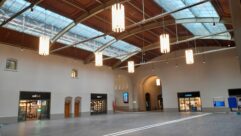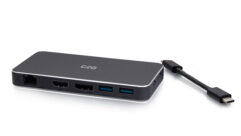

The nearly sold-out
tour this year in support of the band’s new album, Paper Airplanes, is certainly proof-positive that they’ve never been more popular, bringing a tightly knit fusion of bluegrass and country to fans old and new. Though Alison’s award-winning 2007 collaboration with Robert Plant may have briefly elevated her stature to a whole new audience it’s abundantly clear that as a group they don’t need an A-list rocker to pack the house.

Taking charge of the tour’s production is longtime audio frontman Cliff Miller of North Carolina’s
. Last summer, Miller put a pair of newly minted SD10 console through rigorous paces at the 2010 MerleFest, one of the country’s premier Americana and roots music festivals. With that experience being so positive and productive, Miller decided to entrust the Union Station tour to
, placing the consoles at FoH and monitors for himself and monitor team Bernie Velluti and daughter Haley. The nightly challenge of presenting acoustic music in venues ranging from indoor auditoriums to outdoor sheds isn’t lost on Miller, who’s been at it for over 40 years, working with some of the most prominent artists of the genre. He says the SD10 has been a key component on this tour, showcasing the nuances of the band’s sound.
“The console is so amazingly consistent and I’m very pleased with the clean quality of sound we’re getting out of it,” Miller offered. “Mixing an acoustic band like this is probably one of the more challenging things for a digital console… it’s really the sum of all the parts and what goes into the console that affects what comes out. There’s a lot of detail with stringed instruments that you never hear with electric guitars and a lot of the other typical rock ‘n’ roll instruments. It’s important to understand the sound of these instruments because when they’re amplified, it’s literally a balancing act to get that right blend—where the sound system is equalized and isolated enough to keep the instrument resonance minimal and as natural as possible, and the low-end frequencies maintained. And that can change, too, depending on the facility and whether it’s indoor vs. outdoors. Outdoor sheds with vinyl roofs over the audience are a real challenge. There’s a lot of reflection even when you make a point of keeping the PA out of it. It’s very live. I find that even in the varying circumstances, once I get the overall PA tuned the way it needs to be, then my presets work well from day to day, inside or outside, pretty consistently. The only thing that may change is the EQ from day to day. Sometimes Ron [Block; banjo/guitar] may change the EQ on his Fishman Aura DI, depending on what he’s hearing in his ears. That affects what I’m getting at front of house, so I just compensate for that on a daily basis. I let him get it to suit his taste and then I set it to suit mine!”
In addition to the pair of SD10s, Miller’s carrying two DiGiCo SD-Racks, with one serving as an emergency spare, and loves hearing the warm, analog preamp sound.
The outboard gear is non-existent with the exception of the Lab Gruppen Dolby Lake LM 26 processor. “The way I’m inserting the Lake processor—which is digitally inserted using the AES sends and returns for my mains, front and side fills—I’m driving it with matrix outputs to the input of the delay. But on the returns, I have three stereo aux sends set up so its coming into the insert IN, so the biamped output of my Lake for my front and side fills and my stereo subwoofers are all being sent from stereo aux sends. Having the insert features is really handy on the console for driving multiple lines and getting signals. Depending on the venue, and if we’re using an in-house sound system, I’ll send all the sends off the console to analog outputs, if that’s where their inputs are. Otherwise, I can send them from the SD Rack on the stage. It’s very versatile, easy to route outputs, and you can rename them for whatever you need. You always have enough. And I really love having those two-two spaces on the SD-Rack underneath for a total of 4 rack spaces. On one side I have a UPS just as a backup in case we lose power, and on the other side, I have the Lake processor, a spare USB pre for my Smaart rig [the Rational Acoustics’ equalization software], and a receiver for a TM400 Lectrosonics test and measurement microphone. There’s not an outboard rack, you just set up the console, plug it in, and I’m ready to go!”
The core of Union Station is a 5-piece band featuring Dobro phenom Jerry Douglas, with the addition of a drummer and a keyboardist for this tour. Miller’s utilizing approximately 34 inputs for the band, much of which is dedicated to a band-wide package of Shure microphones for drums, fiddle, guitars, banjo, lap steel amp and vocals, a Neumann TLM 193 on the bass cab, as well as Fishman Aura DI’s for guitar, banjos and Dobro [the Jerry Douglas signature model], and various inputs for playback iPod, etcetera. A nightly encore finds the group singing in old-timey fashion gathered around a Shure KSM44.

Miller’s output section is fairly minimal, comprised of Left and Right outs, with the occasional Left Right Upper and Left Right Lower. “I always have a Left/Right, side fill, front fill, delay mix, and always provide an ADA house mix for the hearing impaired. One is dedicated for my Smaart computer. It’s an industry-wide reference software package that I use for tuning the sound system into the room environment itself, and for PA time alignment. It’s invaluable and I use it every day… very affordable, very versatile and it really fills a niche for me.”
Within the console, Miller’s effects rack is minimal, consisting of about 4 reverbs and 2 delays. “I’m using the simple vocal plate for Alison’s vocal and the backup vocals, and a simple delay that I use mainly for the Dobro to get a pan effect in some of the slower songs that we do. Other various reverbs I use are for percussion, and I have a warm hall delay that I use on guitars. Obviously in an auditorium, a little reverb on the instruments is always nice. It’s a pretty basic setup because, after having worked with them for 11 years, I try to be as true to the instrument’s sound—and to the recordings—as possible. The music they play has a wide dynamic range, and I like to make the most use out of that, so there’s very little compression.”
Macros and snapshots are two of the must-have features for Miller’s daily workflow. “I like being able to record a macro of an EQ setting that I can use for one particular instrument in one particular song. Typically, I have my console set up so when I have an EQ for a guitar it stays the same through all the snapshots. But when they change instruments using the same line, using the macros I can bring up the EQ I prefer when, say, Ron plays the Banjola on ‘Sinking Stone,’ which is a radically different EQ then I use for his guitar on another song. It’s very simple for me at FoH to be able to recall what I need quickly. I also have an ADK Lyve Tracker digital workstation recording 56 channels at 96K to create a ‘virtual soundcheck’. The SD-10 outputs MADI to Lyve Tracker and at the bottom of the playlist I have a playback snapshot for recalling the output from the Lyve Tracker to the inputs of the console for playback. I’m also using Time Fade a bit between songs, where they go from one song right into another. I can use that to ease in the drums and other instruments and it works very nice. I can just hit the scene and let it transition.”

The SD10 at monitor world is set up and shared for Haley Miller and Bernie Velluti to manage their respective areas—Haley for Alison specifically, and Bernie for the rest of the band. “I set the console up and layered it so I have all my channels on one side of the board and Bernie can have the other side for his. This worked well for us, and it was great to have two sets of eyes on the band at all times. I love the versatility of the board. Being the first time on a DiGiCo, I found it seemed almost limitless in how I could customize the console to my specific needs. The rotary knobs are assignable. For example I’m able to bring my head amp, high pass filter and Pan control right above my channel fader. Within a push of a button the rotary knobs toggle between my settings and Aux sends. The best feature for me, though, is the ability to control the surface offline, although it will get you in trouble if you are not careful. We have a scene for every song and everyday there are some variances in instrumentation, such as proximity of the subs, it changes day to day and affects the level of bass that is put in the ears. As well as pedal boards, they are never the same, even when you mark every knob. Making the appropriate adjustments for these channels has been so easy. Without interrupting audio within the current scene, I’m able to take the surface offline, fire any scene make changes, save and return to audio before the song ends. If I need to make the same change in all or just select scenes, I can edit Range, make the change and confirm it within all the ones selected.

“I’ve really enjoyed working with this console and it will be difficult to jump back on something else when we get back into the shop. The clarity is there for Alison, who is using the Sensaphonics 2Max earbuds with a Shure PSM 900 belt pack. She has told me, ‘It’s so clear and full’. You can really gain it up and it has such a nice fluid transition.”
That low latency rate is one of the console features that resonated with Miller, as well. “I own probably 6-7 other digital consoles now, and these were the first two DiGiCo’s I’ve purchased,” he explained, “and I couldn’t be happier with them. Quite frankly, I really like using the digital consoles we used before, but it came down to the fact that I was looking for a company that was taking advantage of the newer technologies. Having a 96k sampling rate is very important for a low latency sound—and especially for Alison’s in-ears, which is critical. Not to mention the Optocore system. The fact that I can use a tactical fiber for my whole snake line for 96 channels is great. It saves me so much time every day and in some of the situations where I run snake that can be like 500 feet long sometimes! It’s small and easy to hide up against the base of the step where no one’s tripping on it. Frankly, I couldn’t be happier with these consoles.”
“And also, I knew these consoles were going to be versatile after this tour, when we get back to business at home,” he added. “We do a lot of concerts with symphony and a rock & roll bands playing together and having a console where I can get 96 inputs and not take up anymore than 4 seats in an auditorium, 3 rows deep is great. Promoters love that! They’d rather sell tickets.”










